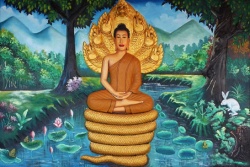Infinite Life Sutra
Venerable Master Chin Kung Translated by Pure Land College Translation team
Foreword
Respected venerables and respected fellow practitioners:
For this lecture series at Ta Kioh Buddhist Temple, I plan to give four lectures, eight hours in total, to introduce the Infinite Life Sutra. The Infinite Life Sutra is called The Longer Sutra in the Pure Land school. I have given several lecture series on it in the United States.
In the past few years, the Buddhist Canon has been printed in Taiwan and circulated around the world. After more than ten times of reprinting, the number of copies circulated is very impressive. The Chinese classics such as Complete Library of the Four Branches of Literature and Selections from the Four Branches of Literature have also been published and given to libraries around the world. Therefore, there is no fear of their being lost to the world.
The literary treasures are abundant, but it would be a shame if no one reads them. How many people have an opportunity to read the Buddhist Canon from beginning to end even once in this lifetime? And when they attempt to read it, they may not be able to comprehend it.
It occurred to me that important passages in the sutras can be excerpted and compiled into a book to facilitate reading, studying, and practicing in life. In this way, traditional Chinese culture and Mahayana Buddhism will truly be able to benefit all beings.
Master Hongyi’s Wanqing Ji is a collection of excerpts from the sutras and quotations from the patriarchs, 101 of them altogether. I once lectured on the Wanqing Ji in an easy-to-understand way and the audience liked it very much. Therefore, I feel studying the excerpts is worth trying. This time I have taken sixty excerpts from the Infinite Life Sutra. If this experiment is successful, I think that the Buddhist Canon can be studied in this way. The Taisho Buddhist Canon is one hundred
volumes. If it is condensed into one volume, studying it will be more convenient. The voluminous classics like the Complete Library of the Four Branches of Literature and Selections from Library of the Four Branches of Literature can also be condensed into one or two volumes by excerption. This way, in the future, everyone will be able to read them.
Exception requires identifying the essence. This is a must. It is like finding the right medicine for an illness. What symptoms are present society and people exhibiting? Today, society is in disorder. People have conflicting thoughts. They feel helpless and do not have any sense of security.
When we look into the root cause, we find it is none other than
- (1) people not maintaining proper relationships with others,
- (2) the loss of morality, and
- (3) people ignoring the principles and truth of the law of cause and effect.
These are the main causes of today’s problems in society. This is why our excerptions should focus on morality and the principles and truth of causality. The sixty excerpts were chosen based on problems in society. The focus was not on Pure Land practitioners. For Pure Land practitioners, instead of these excerpts, I would definitely choose the forty-eight vows and chapters 32 to 37. These are the chapters Pure Land practitioners must study and understand.
Reading these sixty excerpts is the same as reading the entire Infinite Life Sutra. It is impossible for a sutra to suit one’s capacity from beginning to end. There may be parts that seem boring and that are not applicable for the reader. The reader may thus lose interest.
The excerpts, on the other hand, are all essence. Whether one reads them or listens to lectures on them, one will be highly interested to learn and practice them.
